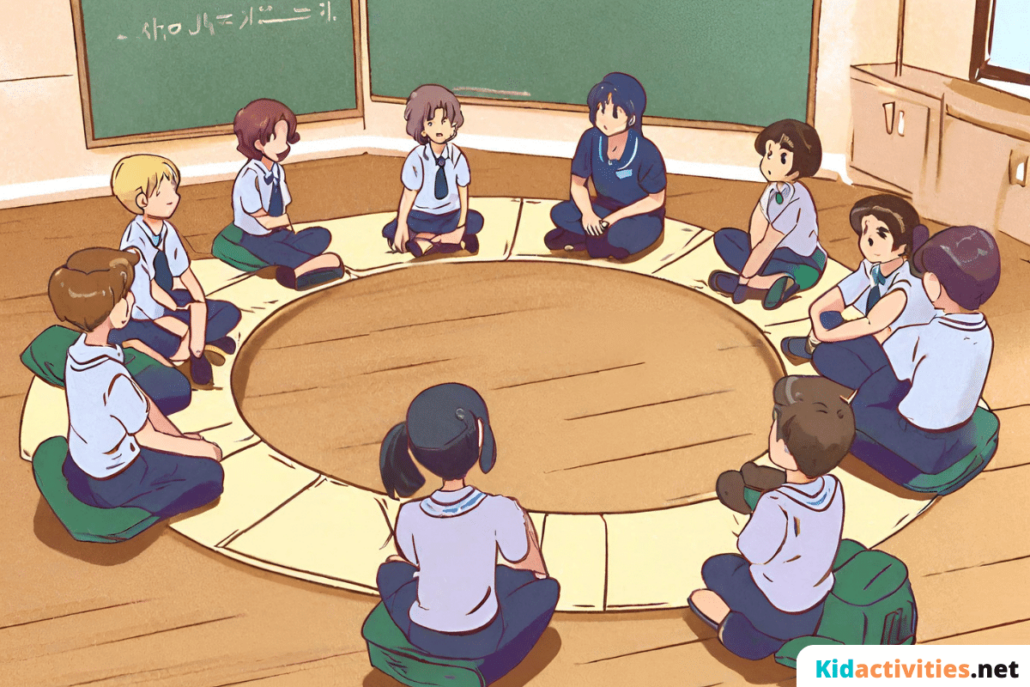Morning Meeting is part of the Responsive Classroom, which is a student-centered method of teaching which centers around engaging academics, positive community, effective classroom management, and developmental awareness.
Morning Meeting is a great way to build community within the classroom, encourage strong relationships, and build trust among classmates. It is a great way to start the day with a positive note and foster student engagement, right at the beginning of the day.
In a Morning Meeting session, there are four key components.
- Greeting – This is a great opportunity for all students to interact with each other by greeting everyone by name.
- Sharing – Students will have the opportunity to share about their lives. Listeners will respond with either comments or questions after the sharer is done speaking.
- Group Activity – The entire group will complete a short activity to encourage togetherness such as a game, song, etc.
- Morning Message – The teacher will write a message to the students about the day’s events.
Though primarily used in kindergarten and elementary classrooms, morning meeting can be used in any age classroom, even in middle or high school.
Making the Most out of Morning Meeting
Do teachers really have enough time during the day to add in one more activity? Does this take a lot of time to plan?
In my opinion, Morning Meeting IS worth the initial time it takes to plan! It does get easier the more you do it!
I’m including some of the best tips I’ve learned about incorporating Morning Meeting from the decade I’ve spent in education.
Here are five tips for making the most out of Morning Meeting.
Tip #1 Keep your morning meeting time to between 15-30 minutes, depending on the age and grade level.
It is true – teachers do have a lot of curriculum to cover during the day. However, I believe Morning Meeting is such a great use of time! It sets the tone for a great day of learning.
You don’t want Morning Meeting to be too long so that it’s difficult for students to sit through nor too short that students don’t have time to properly connect with the goals and purpose of Morning Meeting. It should be the right length of time.
For this reason, it is recommended to keep Morning Meeting to between 15-30 minutes and adjust according to the age and grade level. Morning Meeting should be something to anticipate, not dread!
Tip #2: Have a collection of greetings, sharing, and activity ideas.
In college, I took a class on teaching Kindergarten. I remember cutting out pieces of paper on colored construction paper and using a metal ring to keep all of the pieces organized into a book. It was a list of greetings to use during Morning Meeting and was so helpful when I had my own Kindergarten classroom.
As time went on, I gathered helpful, fun, or engaging greeting and activity ideas so that it was easy to choose which one I wanted to do each morning.
I even laminated stacks of cards to keep them neatly preserved. This became a huge time-saver and helpful tool in creating a great Morning Meeting schedule.
There are a lot of ideas out there for greeting ideas. Here are a few examples to get started:
- Dance move – greet each classmate with a new dance move.
- Sign language – teach students how to sign “good morning.”
- Foreign language – say “good morning” in another language.
- Speed greeting – try to say “good morning” as quickly as you can to everyone in the class.
- Compliments – say “good morning” and give a compliment to the classmate you are greeting.
Here are some ideas for sharing:
- Ask a simple question such as, “What will you do this weekend?”
- Ask “would you rather” questions
- Ask questions from class yesterday
- Have students share about a book they’ve been reading
Here are some ideas for activities:
- Rock, paper, scissors – have students play rock, paper, scissors in rounds until you find the ultimate class champion.
- Silent ball – throw a ball around the circle. Whoever talks or misses a throw is out!
- Human knot – have students hold hands with others in the circle and try to get untangled.
Tip #3: Use this time to check in on your students.
One of the main goals of Morning Meeting is to build a strong classroom community, but another important goal is to create a space for students to be heard. Use this Morning Meeting time to listen to your student’s answers. How are they doing? Are there any opportunities to build connections?
Tip #4: Adapt to your grade level and classroom.
Make Morning Meeting your own. Customize the schedule so that it fits the needs of your own classroom. Sixth grade students are not going to be doing the same activities as kindergarteners. In lower grades, you may also choose to incorporate other routines such as morning work, day of the week, weather report, or counting the school days.
Tip #5: Create a space that accommodates your Morning Meeting goals.
Set up your classroom for success! Plan out where you’ll have Morning Meeting. Will everyone fit if you sit in a circle? How can you include everyone? Try to avoid having to move big things like desks, bookcases, or furniture each time you have Morning Meeting.
It can be helpful to have a whiteboard or screen at the front of the classroom to use when displaying the teacher’s greeting. Are there any materials like whiteboards, clipboards, whiteboard markers, books, etc. that are often used for Morning Meeting? Try to keep these in an accessible spot in the classroom for ease and efficiency. And of course, a big carpet or rug can make the space complete!
Trying it out for yourself
Whether a first-year or veteran teacher, it is never too late to add, change up, or revive your Morning Meeting time! Morning Meeting is such a great way to set students up for success by creating a positive classroom environment, building a strong sense of community, engaging academics in meaningful ways, and practicing effective classroom management through relationship.
I have personally seen how Morning Meeting has impacted class dynamics for the better and can’t recommend it enough for cultivating a strong classroom community.

